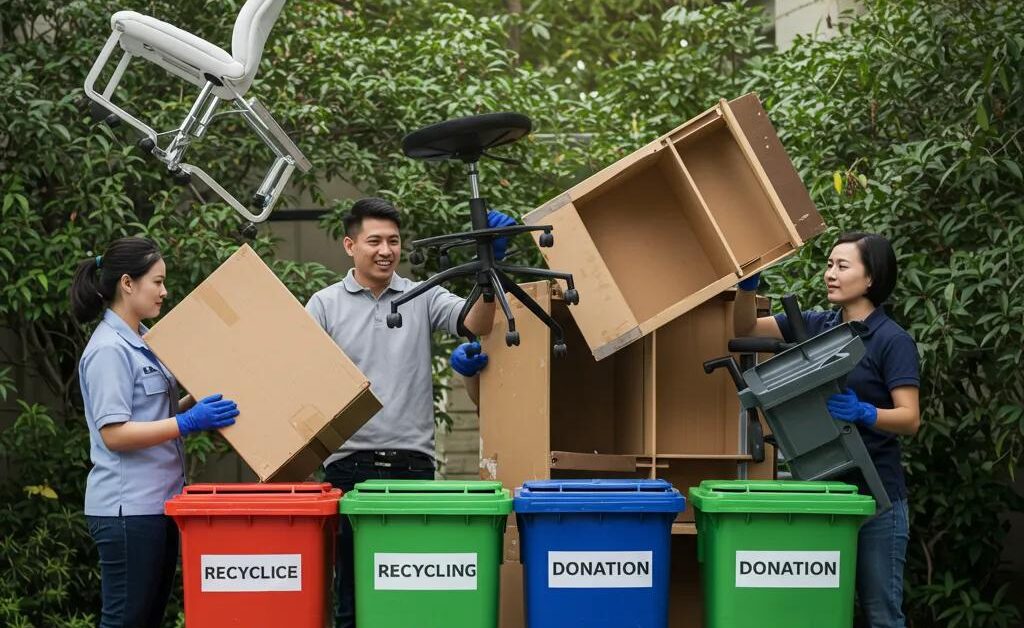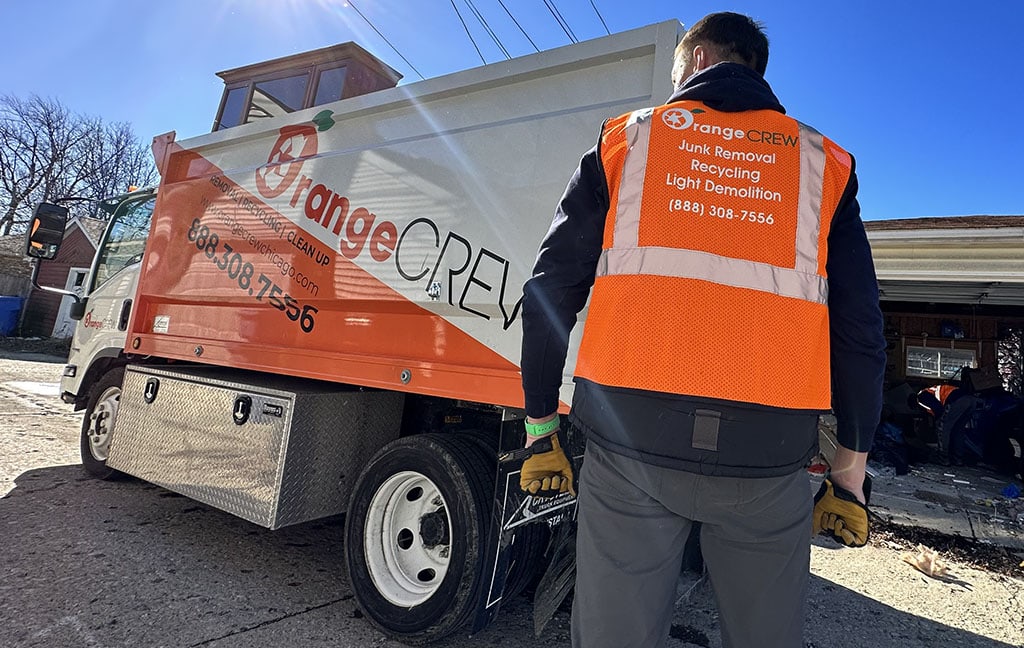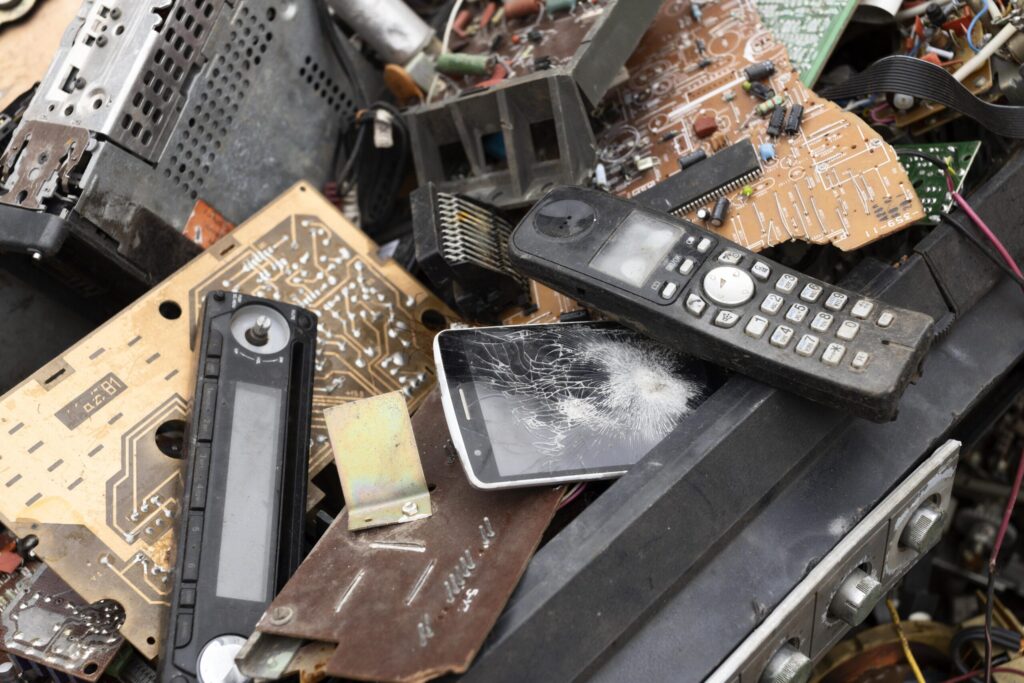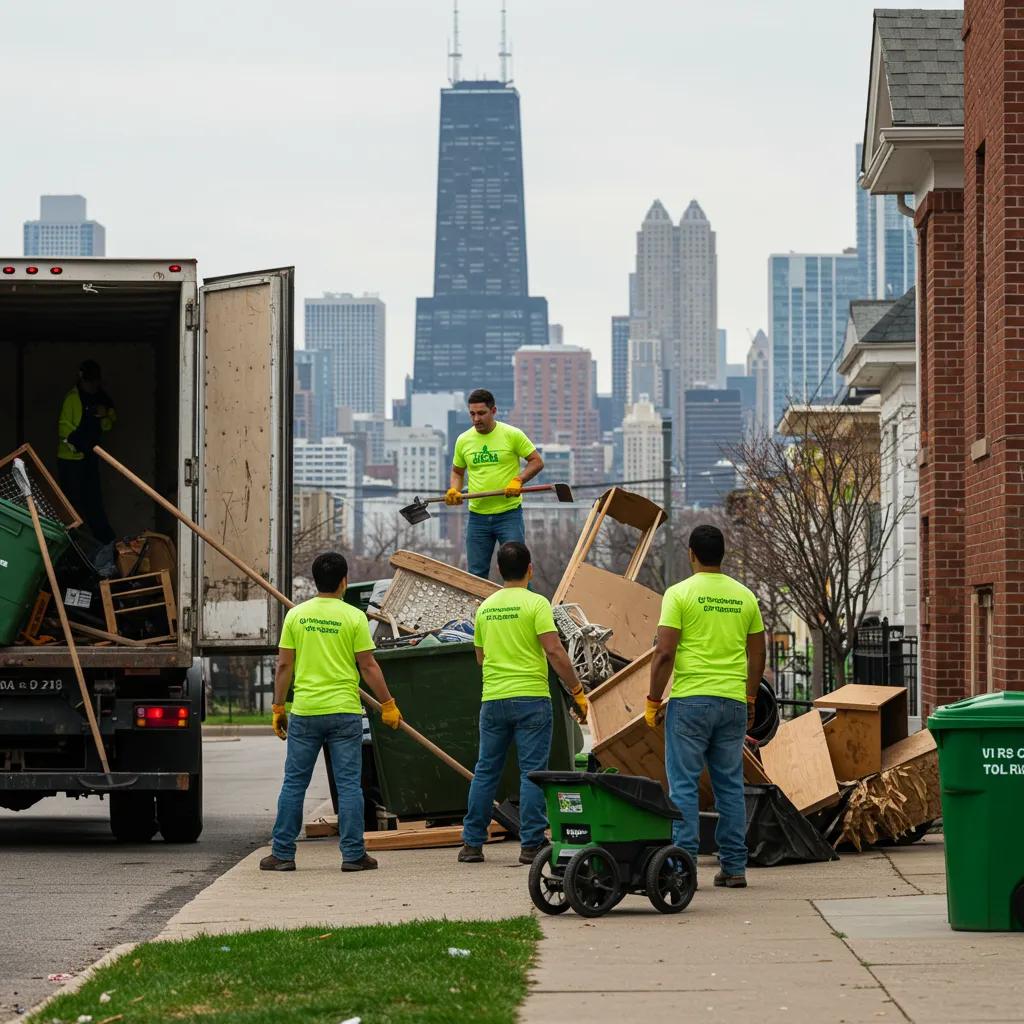Preparing an office for a major furniture change sounds simple—until you’re actually in the middle of it. One minute everyone’s working peacefully, and the next, desks are being shifted, boxes are piling up, and your team is dodging chairs in the hallway. That’s exactly why planning ahead matters. A well-organized approach keeps your workspace running smoothly while still giving you room to upgrade, rearrange, or clear out old pieces.
Whether you’re expanding, updating, or finally getting rid of those bulky filing cabinets from 2009, the goal is the same: make the process fast, safe, and disruption-free. And that’s where working with a reliable office junk removal service becomes a game changer. Professionals know how to handle furniture safely, coordinate around your team’s schedule, and streamline the entire process—from hauling to responsible junk disposal.
In this guide, you’ll learn how to prep your office the right way so furniture removal doesn’t derail productivity. You’ll get practical tips, smart planning strategies, and insights that make the whole experience smoother—especially if you’re partnering with experts like a local furniture removal Chicago team. By the end, you’ll feel confident and fully ready to tackle your next office cleanup or upgrade.
Assess Your Office Layout and Identify What Needs to Go
Before anything gets moved, hauled away, or replaced, you need a clear picture of what you’re actually dealing with. Think of this step as the “office reality check.” It’s easy to assume you know what’s staying and what’s going—but once you start walking around with a critical eye, you’ll be surprised by how much unused or outdated furniture is just taking up space. Taking time to assess your layout not only keeps your project organized, it also helps your office junk removal service work faster and more efficiently.
Conduct a Full Furniture + Equipment Audit
Start with a simple walkthrough. Grab a notebook or open a notes app and list every major furniture item in your workspace—desks, chairs, shelving units, cubicles, breakroom furniture, storage cabinets, and anything lurking in corners or storage rooms. From there, divide your list into categories like Keep, Replace, Donate, or Send for junk disposal.
This exercise helps you quickly spot what’s outdated, damaged, or no longer needed. It also allows your commercial junk removal team to get an accurate sense of the volume they’ll be handling. The more detailed your list, the smoother the process later on.
Identify Workstations and High-Traffic Zones
Next, map out the sections of your office that see the most daily activity. These are areas where you’ll want to avoid unnecessary disruption during the removal process. Think about departments with steady workflow, customer-facing spaces, or zones where employees frequently move around.
Visualizing your layout helps you plan removal routes that avoid bottlenecks. It also gives your office junk removal service a better understanding of how to move furniture without getting in the way of your team. Professionals rely on these layout insights to navigate office spaces safely and quickly.
Determine Special Removal Needs
Not all office furniture is created equal. Some items need to be dismantled before moving, while others may require extra hands or special equipment. Large conference tables, old cubicle systems, or heavy storage units often fall into this category.
Flag anything that looks oversized, fragile, or uniquely shaped so your removal partner can prepare the right tools ahead of time. If you’re working with a local team—like a furniture removal Chicago service—they’ll already be familiar with building rules, elevator limitations, and tight hallways common in office buildings.
By the end of this assessment, you’ll have a clear, organized view of what needs to go, what stays, making your office furniture removal experience a smooth one.
Create a Removal Timeline That Minimizes Disruption

Once you know what needs to go, the next step is making sure the actual removal process doesn’t interrupt everyone’s day. A thoughtful timeline is your best friend here. It keeps your team informed, helps your commercial junk removal partner stay on schedule, and prevents those last-minute scrambles that can throw off productivity. With a little planning, your office can continue running smoothly—even while desks and chairs are being hauled out.
Choose the Right Day and Time
Timing is everything. If your office has peak hours—like busy mornings or client-heavy afternoons—avoid scheduling any major movement during those windows. Early mornings, late afternoons, or even weekends often work best because your team isn’t actively using the space.
By choosing a removal time that naturally has lower foot traffic, you reduce noise, avoid blocking walkways, and keep everyone focused on their usual tasks. Many office junk removal service teams are flexible, so don’t hesitate to ask for off-hours or staggered scheduling if that fits your workflow better.
Build a Step-by-Step Internal Timeline
Think of this as your roadmap for the entire project. Break everything down into small, manageable steps so nothing gets overlooked:
-
When to notify employees
-
When departments should pack personal items
-
When electronics need to be unplugged
-
When hallways should be cleared
-
When the commercial junk removal team will arrive
This structure prevents confusion and gives each department plenty of time to prepare. It also eliminates the “rush effect,” where everyone suddenly tries to pack and reorganize at the last minute.
Coordinate With Your Commercial Junk Removal Partner
Your removal team plays a huge role in keeping the day running smoothly. Share your internal timeline with them so they can adjust their crew size, equipment, and strategy around your schedule. Communication is key here—let them know about tight spaces, elevator access, or special building rules your office may have.
Working with professionals who understand office environments—especially local experts like those specializing in furniture removal Chicago—can make a big difference. They’re used to navigating busy buildings and can tailor their approach to minimize disruption.
By having a clear, well-planned timeline in place, you’ll set the stage for a smooth, frustration-free removal day. Everyone knows what to expect, your team stays productive, and your office junk removal service can do their job quickly and safely.
Communicate Clearly With Employees and Set Expectations
Even the best-planned furniture removal can cause confusion if employees aren’t kept in the loop. Communication is what keeps everything calm, organized, and predictable. When your team knows what’s happening, when it’s happening, and what they need to do, you avoid misunderstandings, delays, and those awkward moments where someone walks into work surprised to find their desk temporarily missing. Clear expectations help your office junk removal service work seamlessly around your staff and space.
Send Company-Wide Notices
Start by sending out an announcement as soon as plans are confirmed. You don’t need anything fancy—just an email or a company-wide message that explains:
-
What’s being removed
-
When the process will happen
-
Which areas will be affected
-
What employees need to prepare
Make it simple and straightforward. People appreciate being included early, especially when it involves their workspace. Giving everyone a heads-up also reduces the number of last-minute questions you’ll need to answer later. You can even post reminders on bulletin boards or Slack channels to keep the message top of mind.
Address Employee Concerns Early
Furniture removal can raise practical concerns, and it’s best to handle these before moving day. Employees may worry about noise, temporary workspace shifts, blocked walkways, or how long the removal will take. Let them know you’re aware of these potential issues and that you’ve partnered with a professional commercial junk removal team to keep everything as smooth and non-disruptive as possible.
Encourage your team to share questions or concerns ahead of time. A quick Q&A session—whether in a meeting or through email—can help everyone feel more comfortable with the process.
Delegate Department Responsibilities
Instead of trying to manage every detail yourself, assign point people within each department. These individuals can help coordinate prep tasks like packing, clearing desks, or labeling items that should stay or go. This makes communication more efficient and ensures nothing gets missed.
Plus, when your office junk removal service arrives, having organized departments makes the process faster for everyone. Removal pros can focus on hauling and disposing, while team leads keep their areas ready and accessible.
Clear, consistent communication keeps your office running smoothly while old furniture moves out. When everyone understands their role and what to expect, your workspace stays productive—and your commercial junk removal team can get the job done without unnecessary interruptions.
Prepare Workspaces for Safe and Efficient Furniture Removal
With your timeline set and your team informed, it’s time to get hands-on. Preparing the physical workspace before the removal crew arrives makes everything smoother, faster, and safer. A little prep goes a long way—not just for your employees, but also for the commercial junk removal team that will be navigating your office. The goal here is simple: create a clear, organized environment that allows furniture to be removed without damaging the space or disrupting your workflow.
Clear Desk Areas and Personal Items
Before anything gets moved, employees should pack up personal belongings and tidy their workstations. This includes photos, mugs, notebooks, chargers, plants—anything that isn’t permanently attached. Clearing desks doesn’t just help the removal crew; it helps prevent lost or damaged items.
Encourage staff to label boxes or bags with their names or department to keep everything organized. A quick reminder a day or two before removal can ensure everyone’s items are packed and out of the way, making it easier for your office junk removal service to access the furniture they need to take.
Disconnect Electronics the Right Way
Electronics are often the trickiest part of office prep. Computers, monitors, printers, phone systems, and chargers all need to be unplugged and carefully stored. Before disconnecting anything, consider taking photos of cable setups to make reassembly easier. This simple step can save your IT team hours later.
Once everything is unplugged, bundle cords together, label them, and store devices in a safe, designated area. This makes it easier for the removal team to maneuver large furniture pieces without accidentally damaging equipment or tripping over cables.
Protect Floors, Walls, and Common Areas
Furniture removal can involve a lot of movement, especially in tight office spaces. To prevent scuffs, scratches, or dents, take a few minutes to protect high-traffic areas. Lay down temporary floor runners, use corner guards, or install padded barriers along narrow hallways.
Professional commercial junk removal crews often bring their own protective materials, especially when handling larger-scale office projects. But doing some prep in advance ensures your office stays in great condition—especially if you’re in a busy building with shared hallways or elevators.
Designate Pathways and Loading Zones
Before removal starts, make sure all walkways and exit paths are completely clear. Boxes, rolling chairs, personal bags, and office décor can easily create obstacles. The cleaner the path, the faster your furniture can be transported out of the building.
Walk the removal route yourself to ensure it’s accessible from start to finish. If your office is in a city with strict building rules—like many furniture removal Chicago projects—confirm loading dock access, elevator reservations, or parking arrangements in advance. These details can make or break a smooth removal process.
Taking time to prep your space not only protects your office but also speeds up the entire process for your office junk removal service. By clearing, disconnecting, protecting, and mapping out the workspace, you set the foundation for a stress-free, efficient furniture removal day.
Also Read: How to Prepare for a Junk Removal Pickup: A Simple Checklist
Make Office Furniture Removal Stress-Free and Seamless
Prepping your office for furniture removal doesn’t have to disrupt your entire workday. With a clear assessment of what needs to go, a smart timeline, open communication, and a bit of workspace preparation, you can keep your team productive while everything gets moved out smoothly. And when you partner with a reliable office junk removal service, the process becomes even easier—especially with experts in commercial junk removal and efficient junk disposal.
Whether you’re reorganizing, upgrading, or clearing space for new equipment, the key is planning ahead and working with professionals who understand office environments. If you’re ready to make the transition seamless, consider connecting with a trusted local team—especially if you need furniture removal Chicago specialists who know how to handle busy buildings and tight schedules.
Take the next step today and make your office upgrade or cleanup a smooth, stress-free experience.








